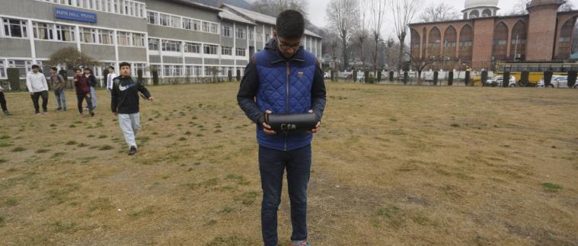Innovation in times of an internet ban: A Kashmiri boy’s journey to the Indian Science Congress |

What do four boys with an idea do in times of an internet ban, a school shut-down and frequent curfews? They learn resilience and resourcefulness, according to their teacher.
In June 2019, four students of Burn Hall School, Srinagar, started working on a science project. Seven months, revocation of Article 370, suspension of internet services and an interrupted school session later, the carbon smoke absorber they created was showcased at the 107th Indian Science Congress, inaugurated by Prime Minister Narendra Modi.
How did they manage the research without the internet?
“Kashmiris have learnt to make do. We get by without many things considered a given outside the state,” says Najma Nazir, science teacher at Burn Hall. “Because we can’t always rely on the internet, our students are in the habit of consulting books. And we pool resources. For the project, several science teachers at the school brainstormed. The students, too, showed a lot of initiative.”
The lack of internet wasn’t even the biggest challenge.
“After August 5, we thought the event would be cancelled in the state. There was no way to confirm anything, or speak to each other,” says Numair Muzaffar Wani, the Class 9 student who led his team and travelled to Bengaluru for the ISC.
In October, the school heard the event was on. This was the time when classes hadn’t resumed, and phone connections, including landlines, weren’t dependable.
“We didn’t know how to get this message to our students. It wasn’t easy to go anywhere, what with the frequent road closures and all the uncertainty and fear. We finally managed to send someone to Numair’s house, who informed the others and they then got together at school,” says Father Sebastian Nagathungal, school principal.
“Once we met, we divided our assignments. My father travels to Jammu for work. He would carry a pen drive and get me the articles I needed. My friends, Hanan Wani, Mueed Nisar and Ahmad Pathan, also managed what they could,” says Numair.
What is the project?
“The carbon smoke adsorber is essentially an anti-pollution device. In Srinagar, 55 per cent of the pollution is caused by hamams — stone rooms where people burn wood for warmth. Our device can be fixed to the hamam chimneys. It has an exhaust fan to suck in the smoke, and then a unit filled with activated charcoal and walnut shells, which can absorb carbon dioxide and carbon monoxide. Thus, the smoke released into the atmosphere is far less polluting,” explains Numair.
“The idea of the activated charcoal first came to Mueed. We worked together to give shape to the rest of the project. It was my friends who decided to elect me as leader of the team,” he adds.
Of misses and messages
Even after the internet ban was side-stepped, there were other difficulties.
“They needed PVC pipes, hot glue, 12-watt battery, wire gauge and an exhaust fan. But times were such that buying all this was a challenge,” says Nazir.
The project was supposed to go through a district-level and a state-level competition before the national Congress. The district-level round was cancelled, but the state-level event was held in November in Jammu.
“They then sent us an email saying we had been selected for the national-level event. How was I supposed to get emails without the internet?” says Father Nagathungal. “Four day before the event, someone from the government called up a teacher who had escorted one of our students to an earlier edition of the Congress. But we needed the internet even to book tickets.”
The tickets were arranged. “I needed to email the Congress our project abstract. My father carried it in his laptop to Jammu, but ultimately couldn’t send it. Mine was the only project without a printed abstract in Bengaluru,” says Numair.
However, at the event, he was “flooded” with visitors. “So many people came to my stall that I couldn’t speak to the other participants. I think half the interest was in my project, but the other half was because I was from Kashmir,” he says.
‘Come to school, but not in uniform’
While all this was happening, the school was battling another challenge — how to get classes back on track, without putting students in danger. “The administration was pressuring us to get classes going, but there was so much fear that no parent wanted to take the risk. We realised sending out school buses was a bad idea when one bus was pelted with stones. And this was in the “sanitised” part of the city. We didn’t dare send buses to Old Town,” says Father Nagathungal.
“We started off by holding two classes a day,” says Nazir. “Teachers would car-pool. Students would be dropped off by parents, but not in uniform, as that could have provoked a reaction from those calling for a boycott. Classes resumed only by November,” she adds.
How are students kept motivated among such interruptions?
“One gets used to anything,” says Muzaffar Wani, Numair’s father and bank official. “This is the life our children have known, an utterly lifeless life.”
“We have accepted this to be the normal, but there’s frustration when we look at children in other states.
Sometimes I panic — how will our children compete with others,” says Dr Aubida Ahad, Numair’s mother, who works at a Naugam hospital.
“You know, for schools, the worst of militancy wasn’t as bad as this,” says Father Nagathungal. “I remember once in the 90s, there was a blast on that road outside. All the glasses in my office were shattered. But we kept classes running. For the first time, we had to keep the school shut for months.”
“In this period, we video-recorded lessons and distributed soft copies among our students. We have to find a way. If Kashmiris wait for things to get better, life will pass us by,” Nazir smiles.
